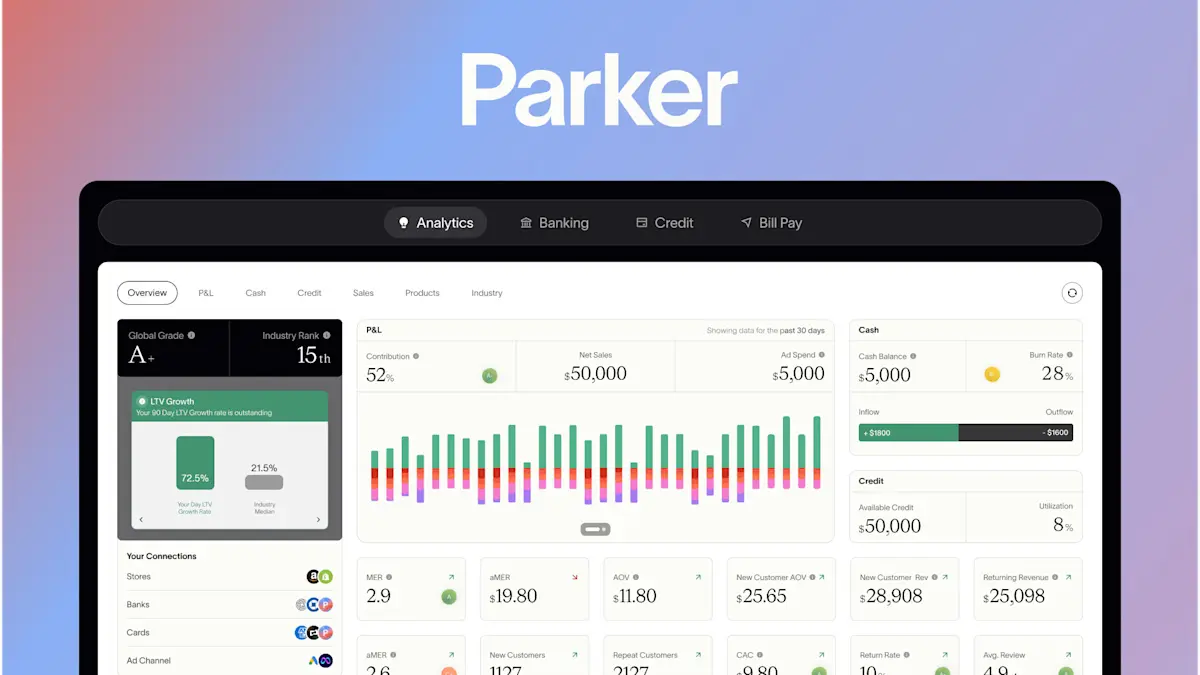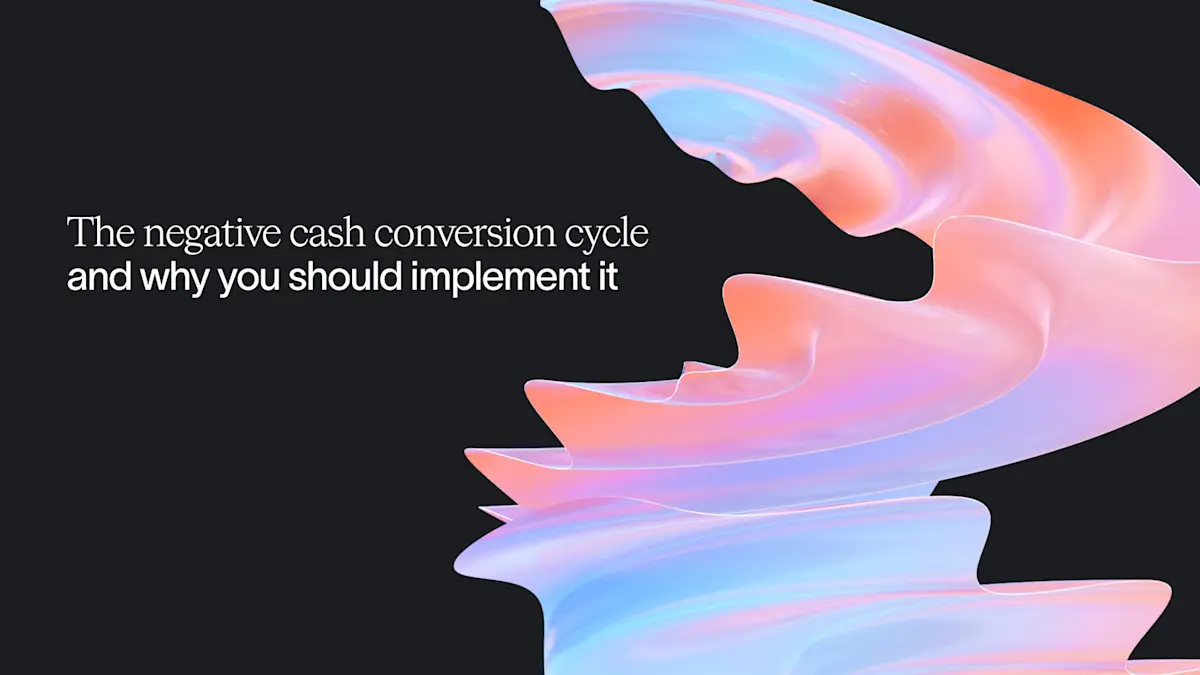What Kinds of Companies Get Funded for Credit?

Access to credit is the lifeblood of any e-commerce business. At Parker, we routinely get questions from credit-curious founders asking: "What factors do creditors and lenders look for to determine credit risk?"
Business credit powers stability and scalability. To sustain growth over time, e-commerce companies need to build strong financial profiles that make them "fundable."
In this article, we explain the 4 key components lenders assess when evaluating creditworthiness for an e-commerce business. But before diving into the details, let’s level set on why credit matters in the first place.
Why Credit Matters for E-commerce
At a high level, credit provides three crucial benefits:
- Ability to invest in growth
- Protect against cash flow challenges
- Fund operations and inventory
For example, lines of credit give businesses the flexibility to pounce when opportunities arise - be it a new marketing channel, acquisition target, or simply needing to stock up on inventory.
Credit also smooths out cash flow bumps. Every business has unexpected hiccups, whether an equipment breakdown or a surprise tax bill. Having accessible capital creates stability and optionality.
Finally, credit can enable you to keep growing on pace with customer demand. Rapid growth strains working capital. Credit can let you stock inventory, fund operations, and deliver excellent customer experiences to fuel growth.
Now let's explore how lenders actually measure creditworthiness and the key indicators that determine "fundability".
4 Factors that Determine "Fundability"
When assessing ecommerce business loans at Parker, we distill creditworthiness down to four key financial profile factors:
- Unit economics
- Working capital
- Liquidity
- Debt
Let’s take them one at a time.
1. Unit Economics
Unit economics refers to per-transaction profitability - whether each individual sale contributes positively to the company's bottom line.
For e-commerce businesses, lenders evaluate historical performance on key profitability metrics like gross margin (what % of sales flow to bottom line profitability?) and operating margin (are you trending towards gross and operating profitability year-over-year?)
The goal is to assess a viable path to break-even or positive unit economics.
Growth stage companies may reasonably operate at negative unit economics for a period if financial forecasts show a clear trajectory toward profitability. Improving margins indicates the business can reach sustainable profitability as revenue scales
Otherwise, negative unit economics that persist indefinitely essentially means losing money on every sale. Some characteristics that hurt unit economics:
- Inefficient customer acquisition costs
- High inventory carry costs
- Excessive fulfillment or payment expenses
On the other hand, positive unit economics show the underlying financial viability of a business. That’s why lenders analyze this metric closely when evaluating funding requests. Improving unit economics signals that profits increase alongside revenue growth. This gives creditors confidence in sustainable margins.
For example, if you have average margins but are doubling revenue yearly, creditors will likely see high growth potential. Optimizing ad spend or pricing to boost margins shows fiscal maturity.
Tip: Carefully monitor gross margins and contribution profit trends over time, not just absolute dollar growth.
2. Working Capital
While positive unit economics indicate profitable transactions, sufficient working capital shows the ability to cover short-term obligations. Sufficient working capital acts as a lubricant to keep e-commerce engines humming smoothly.
The two major indicators assessed are:
- Quick Ratio = (money and equivalents + accounts receivable) / current liabilities Quick ratio shows the ability to convert liquid assets like money and accounts receivables to cover urgent liabilities. Lenders use this ratio to see how “quickly” a company can convert its most liquid assets to pay short-term obligations if they are due very urgently.
- Current Ratio = current assets / current liabilities Current ratio assesses a company's ability to pay off its short-term liabilities with its short-term assets. This tells lenders how a company can maximize the current assets on its balance sheet to satisfy its 1-year obligation.
For example, Company A has $2 million in inventory but only $500k in accounts receivable, while Company B has $1 million in inventory and $850k in accounts receivable. Company B demonstrates greater working capital health despite lower inventory because higher accounts receivable give them more liquidity to fund operations smoothly.
The important thing to remember is, that the higher the quick and current ratios, the more promising it is for lenders evaluating your business.
Tip: Point to inventory and accounts receivable as strong sources of liquidity if working capital is low.
3. Liquidity
Liquidity metrics like cash runway and money/revenue ratio examine capacity to carry on further into the future through reserves.
- Runway tells you how many months you have left before you need to secure additional financing to stay afloat at your current burn rate. Calculated as money in the bank / monthly burn rate.
- Money to revenue ratio compares money on hand to revenue, indicating how much liquidity is available relative to the size of the business.
For example, a company doing $100M in annual sales with only $1M in money has just a 1% ratio - dangerously low liquidity. $5M would be safer at 5% of revenue.
To creditors, a strong liquidity position on a business with average margins and low revenue can be a safer underwrite than a business with poor liquidity, average margins, and high revenue (even if the revenue is $100mm).
Tip: Build liquidity buffers as credit lines before you desperately need them if and when times get tough.
4. Debt
Debt financing can be a lever for growth but requires careful management to avoid over-leverage. Lenders examine debt loads and coverage capacity closely to gauge risks.
Two key ratios lenders assess:
- Long-Term Debt (LTD) ratio: Indicates the level of leverage and financial stability. The higher the LTD, the more levered the business is, and the less safe it seems to lenders.
- Interest Coverage ratio: Shows how easily a company can cover its interest payments on outstanding debt. Calculated as EBIT / interest expense. Generally, higher interest coverage multiples are considered better and safer for lenders.
For example, two companies both have $10m in debt. Company X has $12m in EBITDA to cover it. Company Y only clears $4m in EBITDA, creating a higher risk profile.
Key takeaway: Manage debt wisely and carefully consider your ability to cover interest expenses. Not all debt is bad, but its management is key to financial health.
Credit is a Great Tool to Scale What’s Already Working
Most e-commerce businesses have to be profitable from day one. So when you’re thinking about your finances, profitability is of the utmost importance — you have to build for cash flow optimization.
Credit is a great tool to support healthy cash flow to scale what’s already working.
Having a strong handle on unit economics, working capital, liquidity management, and leverage best practices is key to building a "fundable" company that can tap growth capital smoothly.
Routinely assessing these four pillars provides tremendous signal into operational fitness and adapting when necessary. Getting ahead of vulnerabilities unlocks access to credit and resources exactly when you need them most to stay competitive.
Related Articles
Ready to Join the Financial Revolution?





